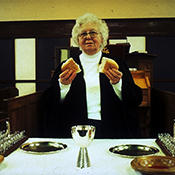 The central Christian rite is the Eucharist, a shared meal of bread and wine. For some Christians, the bread and wine, consecrated by a priest, are the real body and blood of Jesus; for others, the sacraments are powerful symbolic reminders of the meal Jesus shared with his disciples before his crucifixion.
The central Christian rite is the Eucharist, a shared meal of bread and wine. For some Christians, the bread and wine, consecrated by a priest, are the real body and blood of Jesus; for others, the sacraments are powerful symbolic reminders of the meal Jesus shared with his disciples before his crucifixion.
View full album
The central rite of the Christian tradition is the sharing of bread and wine. As in many religious traditions, this act of eating together both creates and sustains the community, just as meals together sustain the life of a family. Sharing food was central to the ministry of Jesus. He did not just share fellowship at the table with an “in-group,” but with the sinners, outcasts, and marginalized of society. It is not surprising, then, that a ritual meal became central to the community of Christ’s followers. St. Paul wrote in his letter to the church at Corinth, “Because there is one bread, we who are many are one body, for we all partake of the one bread” (I Corinthians 10:17).
Sometimes called “Holy Communion” or “the Lord’s Supper,” the most common name for this rite is “the Eucharist,” which means “thanksgiving” in Greek. It comes from the account of Jesus’ last supper with his disciples before his crucifixion, in which he gave thanks to God for the bread and wine before sharing it around the table. The words of the rite repeat that story: “the Lord Jesus on the night when he was betrayed took a loaf of bread, and when he had given thanks, he broke it and said, ‘This is my body that is broken for you. Do this in remembrance of me.’ In the same way he took the cup also, after supper, saying, ‘This cup is the new covenant in my blood. Do this, as often as you drink it, in remembrance of me.’” (I Corinthians 11:23-25). The language of this last meal with his disciples is recited in the rite of the Eucharist, as Christians of every generation take their place at the table.
The “communion” of those who share the bread and wine is not only with one another in the community of the church, but with Christ who is, according to Christians, present with them in this fellowship. For all Christians, these elements are a holy remembrance of Christ. But what does it mean for Christians to eat the “body” and drink the “blood” of Christ? Are the bread and wine symbolic of Christ? Do they become consecrated as the real presence of Christ? Is Christ’s presence in the elements of bread and wine, or is his presence in the community, among those who gather in His name? The discussion of the profound mystery of the Eucharist continues among Christians, even today. They also celebrate in a variety of ways: some take only a small piece of bread and sip of wine, but for others the Lord’s Supper means a full meal; most Catholics and Orthdox churches use fermented wine, but in response to the nineteenth-century temperance movement, many Protestants began substituting non-alcoholic alternatives. Whatever differences Christians may have in interpreting the Eucharist, this rite is of central significance to Christian congregations throughout the world and across denominations. The “bread of life” sustains the spirit, just as the bread of the earth strengthens the body.
In most Protestant churches, Holy Communion is not observed weekly, but perhaps monthly or on special days during the church year. In Episcopal, Disciples of Christ, and Lutheran churches, however, the meal is most likely celebrated every week. Roman Catholic churches celebrate this rite of Holy Communion daily as the culmination of the Mass. Indeed, in most Roman Catholic churches there are several Masses each day to accommodate the needs and schedules of parishioners. In Orthodox churches, the Eucharist is also observed daily and weekly and is called the Divine Liturgy.
Many Christians use this rite to mark progress through life’s stages. In Catholic and some Protestant denominations, young people will study and prepare themselves before taking their “first communion,” which constitutes full entry into the life of the church. Sometimes when a couple is married, they will take communion together as part of the sacrament of marriage. Priests and pastors also often bring the consecrated bread and wine to the sick and dying.
However often or in whatever way this rite is observed, it is the doorway to the heart of the Christian community. Within it, the whole story of Christianity is contained and the whole drama of Christ’s death and resurrection is enacted. The Eucharist is, in the words of the Episcopal communion rite, “the gifts of God for the people of God.” Having been nourished by these gifts, the celebration ends with a mission imperative: to go forth into the world for reconciliation and for service.